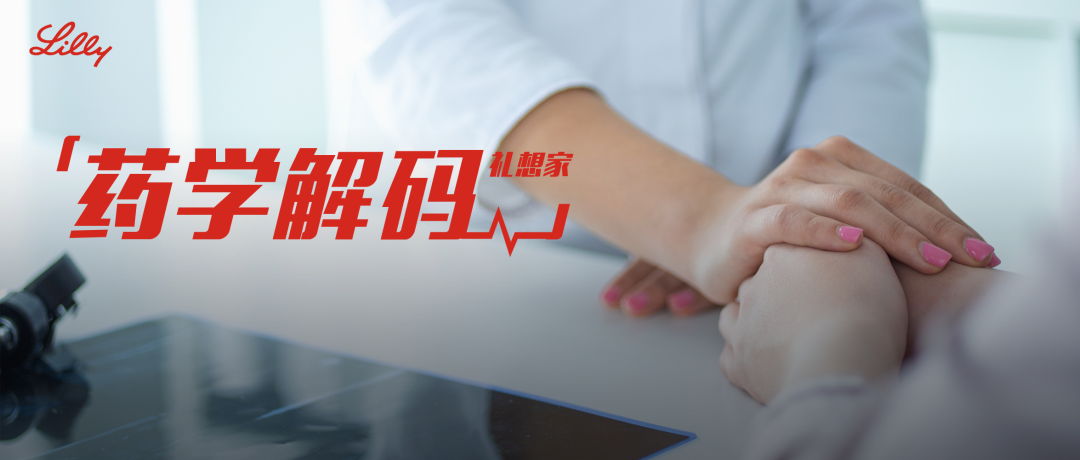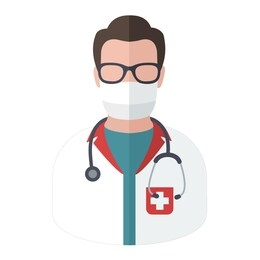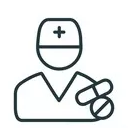

Recently, the Tumor Medicine Joint Clinic received a patient, Aunt Chen, who was suffering from severe itching due to a rash.
➣ Doctor’s Consultation — Causal Thinking to Identify the Cause of Imbalance

Doctor

What seems to be the problem?
I have many red rashes on my hands, and they are very itchy. I have used a steroid cream, which has provided slight relief.


Aunt Chen

Doctor

Is there any rash in other areas?
No, only on my hands.


Aunt Chen

Doctor

Have you had rashes on your hands or other areas before?
No, I have not.


Aunt Chen

Doctor

Have you recently consumed fish, shrimp, or mango? Or any medications?
I have been taking Methotrexate tablets and have been careful with my diet, avoiding those foods recently.


Aunt Chen
(▲ Swipe up and down to view the complete dialogue)
Doctor’s Opinion: Consider the possibility of adverse drug reactions, avoid hot water and scratching, and if necessary, apply topical medications combined with oral antihistamines.
➣ Pharmacist’s Consultation — Seeking Benefits and Avoiding Harm, Correcting Imbalance

Pharmacist

I heard you have many red rashes on your hands. Can you tell me when this started?
It has been about a week.


Aunt Chen

Pharmacist

When did you start taking Methotrexate?
I started last week, around the same time the rash appeared.


Aunt Chen

Pharmacist

Do you remember how long after taking the medication the rash appeared? When was it most severe?
The rash appeared the day after I started taking the medication. I went boating with friends, and when I returned, my hands were covered in red spots, which now look a bit dark.


Aunt Chen

Pharmacist

When you went boating, did you use sunscreen or wear gloves?
I used sunscreen and wore a big hat, but I didn’t wear gloves.


Aunt Chen
(▲ Swipe up and down to view the complete dialogue)
Pharmacist’s Opinion: It is possible that the rash is a photosensitive reaction caused by Methotrexate after exposure to strong sunlight. It is recommended to avoid direct sunlight, wear gloves when going out, and apply sunscreen [1].
It can be seen that the typical doctor’s consultation focuses on “finding the cause of the imbalance,” such as “What are the symptoms? What are the factors causing discomfort?” In contrast, the pharmacist’s consultation aims to “correct and resolve imbalances,” such as “What medications are you taking? How long have you been taking them? What factors may cause harm?” The pharmacist’s consultation is significantly different from the doctor’s, and the role of pharmaceutical consultation in oncology is particularly crucial in clinical practice.
Key Elements for Effective Pharmaceutical Consultation for Cancer Patients — 5 Points to Remember
The uniqueness of pharmaceutical consultation for cancer patients lies in the fact that once a patient is diagnosed with malignant tumors, their quality of life significantly declines, and concerns about treatment outcomes and fears of adverse drug reactions can lead to negative emotions. Additionally, the long treatment cycles and financial pressures can cause patients to develop resistance to treatment [2-3].
Through consultation, pharmacists can promptly understand patient needs and respond actively, such as dispelling doubts about the disease or treatment medications, and eliminating the risk of potential adverse reactions. This is crucial for correcting patients’ cognitive biases, mobilizing their positive psychology, and preventing adverse reactions [2-4]. For such a special patient group, pharmacists should keep the following 5 points in mind during consultations:
1►
Be Direct and Use Guided Questions
Based on a premise of positivity and mutual respect, establish a therapeutic relationship. First, confirm the patient’s name, introduce yourself, and inform the patient of your role as a clinical pharmacist and the pharmaceutical services you can provide during their hospitalization or outpatient visit [5-7].
Consultation Tip 1:
Clearly state your identity and the assistance you can provide to the patient, and encourage them to express any concerns or questions about their medication through guided questioning.[5].
➣ Consultation Example:
Q: **Hello, Aunt, I am ** the pharmacist. During your treatment, I can provide assistance regarding your medications. I would like to understand your concerns about your medication treatment.
Q: How have you felt since ** the doctor changed your treatment medication? (Guided question to inquire about the patient’s outcomes and concerns regarding the medication)
2►
Personalized Approach, Collect Essential Personal Information
Personal information refers to the patient’s basic information and social drug use information. Basic information includes age, gender, height, weight, menstrual history, immunization history, insurance status, and lifestyle habits (diet, exercise, sleep). Social drug use includes smoking and drinking history (including the number of cigarettes smoked and the amount of alcohol consumed) [2,5,7].
Consultation Tip 2:
Use open-ended questions primarily, focusing on the individual characteristics of each patient and the different stages of treatment to guide the collection of personal information, which will inform subsequent thinking and questioning.
For patients before their first chemotherapy, they may feel anxious about the initial treatment. To better assess the risk of chemotherapy-related vomiting and disease recurrence, and to develop preventive and treatment measures to alleviate the patient’s resistance to subsequent treatment [8], it is essential to collect information on age, gender, and smoking/drinking history, as well as insurance status [9-11].
Q: How old are you this year?
Q: Have you ever smoked or drunk alcohol?
Q: Are there any issues with your medical insurance regarding the medications needed for your disease treatment?
For patients undergoing intravenous chemotherapy or taking oral anticancer medications at home, it is important to pay attention to their bowel and bladder habits (e.g., diarrhea caused by Irinotecan, red urine after taking Doxorubicin), dietary habits, and sleep patterns [8]. Additionally, for patients taking oral anticancer medications at home, hidden adverse reactions may occur, so it is necessary to assess whether their exercise habits have changed and evaluate their physical condition.
Q: How many meals did you have today?
Q: How is your urine output? Any abnormal changes in your urine?
Q: How many times did you have a bowel movement? Was it formed?
Q: How much exercise do you get daily?
For patients during chemotherapy intervals, there is a risk of adverse reactions from medications after treatment. To better assess the patient’s tolerance to the current medication regimen, it is important to note any changes in lifestyle habits such as diet, sleep, bowel and bladder habits, and weight changes to guide adjustments to the next cycle of medication treatment [8].
Q: How has your diet been since you got home? How many meals do you eat in a day? What is the approximate amount for each meal?
Q: Has your weight changed since your last hospitalization?
Q: How has your sleep been at home since the last treatment?
For patients in the perioperative period, it is also necessary to collect information on their exercise habits [7].
Q: Do you participate in physical exercise regularly?
Q: What type of exercise do you do? How many times a week?
3►
Listen Actively, Gather Comprehensive Disease Information
Chief complaint, current medical history, past medical history, and family history are all essential.
● Chief Complaint: A brief explanation of the reason for the patient’s visit [6].
● Current Medical History: The development and evolution of the disease and the entire treatment process. Describe the location, nature, duration, and severity of symptoms in chronological order, as well as factors that relieve or exacerbate symptoms, treatment history, and outcomes.
● Past Medical History: The patient’s previous health status and any diseases they have had (including various infectious diseases, injuries, surgeries) [6].
● Family History: Refers to the disease history of first-degree relatives, including parents, siblings, and children [6].
Consultation Tip 3:
Focus on the patient, allowing them to express their condition in their own words. Generally, do not interrupt, and use body language to respond appropriately, such as nodding, to show sufficient attention.[5]Use open-ended questions first, followed by closed questions to guide the patient to provide a clear, complete, and detailed explanation.
When inquiring about past medical history, pay special attention to diseases closely related to the current medical history. For example, the triggers for the current medical history: Helicobacter pylori infection history and gastric cancer [12], hepatitis B history and liver cancer [13], EB virus infection history and nasopharyngeal cancer [14]; for breast cancer, gastric cancer, and colorectal cancer patients, carefully inquire about family history to assess familial clustering or genetic predisposition [9,15-16].
➣ Consultation Example:
Q: What brings you in for treatment this time?
Q: (Nodding) What do you mean when you say you feel terrible? (Acknowledge the patient’s feelings)
Q: Why can’t you stroll in the park anymore? Do you feel weak or fatigued? (Open-ended questions first, followed by closed questions)
Q: Do you feel chest pain when walking?
4►
Four Steps Forward, Detailed Medication Information Required
Medication information should be comprehensive, covering past and current medication records, allergy history, adverse drug reactions, and medication adherence.
● Past Medications: All medication treatments the patient has received in the past (usually within the last 6 months, or from the initial drug treatment for cancer patients). This includes the names of medications, dosage forms, dosages, and actual administration regimens (route and frequency); reasons for taking the medications; duration of treatment and outcomes; and reasons for discontinuation [5].
● Current Medications: All medications currently being used — prescription medications (anticancer drugs, sedatives, analgesics, antihistamines, etc.), over-the-counter medications (cough and cold preparations, oral contraceptives, laxatives, antacids, topical ointments, etc.), Chinese herbal medicines, and health supplements (vitamins, nutritional supplements, etc.). This includes names and dosages, actual administration regimens (route and frequency), duration of treatment, reasons for taking the medications (indications), and treatment outcomes [5-6].
● Allergy History: Allergic reactions are hypersensitive responses to specific antigens or allergens that trigger characteristic symptoms whenever encountered. This includes specific medications or foods that cause allergies (e.g., some vaccines derived from egg products), the types of reactions experienced (e.g., rashes, difficulty breathing, etc.), the dates of reactions, the medications used for treatment, the outcomes of treatment, and whether there are reactions to other medications in the same class [6].
● Adverse Drug Reactions: Adverse drug reactions are harmful responses that occur unrelated to the intended purpose of the medication. When adverse drug reactions are identified, it is important to obtain the name of the medication, dosage, frequency, reason for taking the medication, details of the adverse reaction, and how the adverse reaction was managed (e.g., dose reduction, discontinuation) [6].
● Medication Adherence: Currently, when a patient cannot or is unwilling to adhere to the medication treatment plan, while the physician clinically judges that the medication’s indications are correct and effective, capable of producing expected results without any serious adverse reactions, this situation is defined as poor adherence. Common reasons include: the patient does not understand the medication instructions; the patient cannot afford the medication; the patient is unwilling to take the medication; the patient forgets to take the medication; the patient cannot obtain the medication; the patient cannot swallow or self-administer the medication correctly [5].
(▲ Swipe up and down to view the complete consultation example)
Consultation Tip 4:
Use four steps to inquire about the reasons for taking medications, current medications, actual medication usage, and treatment outcomes through open-ended questions[5], maintaining a non-judgmental attitude, and encouraging the patient to express their medication concerns. Pay attention to details during the inquiry and avoid leading questions.
Quantify the dosage of over-the-counter medications and health supplements [6]. For example, when using Pemetrexed, inquire about the dosage of dietary supplements like folic acid to avoid reducing the drug’s efficacy [17].
For past and current medication records, pay attention to the history of medications with cumulative toxicities. For patients using drugs with cumulative toxicities such as anthracyclines and Bleomycin, detailed inquiries about the patient’s chemotherapy regimen are necessary, including dosages, intervals, and cycles of administration [18], to reduce the risk of adverse reactions.
Medication adherence can be assessed and managed using the ARMS scale [20]. Determining medication adherence is particularly meaningful for patients taking oral anticancer medications [19].
➣ Consultation Example:
Q: What medications have you used for treatment since your diagnosis? (Reason for medication)
Q: Can you tell me specifically how you take this medication? (Avoid using leading questions: You take ** twice a day, right?)
(The pharmacist repeats the patient’s responses to the above questions for confirmation.)
Q: How do you feel after taking it? (Treatment outcome, encouraging the patient to express concerns about the medication or regimen)
Q: Besides the medications you mentioned, are you currently using any other medications or health supplements?
Q: How often do you purchase these medications? (Quantifying the use of over-the-counter medications or health supplements, confirming the patient’s actual dosage)
Q: You mentioned sometimes forgetting to take your medication. What difficulties do you encounter during your medication period? (Exploring the reasons for poor medication adherence)
(▲ Swipe up and down to view the complete consultation example)
5►
Empathy, Understanding the Medication Experience
What is the medication experience? The medication experience encompasses all events that patients undergo during their drug treatment [5]. It mainly includes the patient’s desire for a safe, effective, and economical treatment plan, their understanding of the treatment plan, and their concerns and preferences regarding medication [2].
Consultation Tip 5:
Be proactive, listen patiently, and avoid interrupting easily, providing appropriate encouragement.
Be careful not to mistakenly assure the patient, such as saying, “Everything will be fine” or “I believe you will get better soon” [6]; instead, use phrases like “How can I help you?”
When discussing the safety of medications, the language used to introduce potential adverse reactions of chemotherapy should be appropriate and objective, avoiding exaggeration or concealment, to prevent the patient from developing a fear of chemotherapy or neglecting the reactions caused by chemotherapy drugs [8].
By mastering the five key elements of pharmaceutical consultation for cancer patients, combining professional knowledge of anticancer medications with consultation skills, pharmacists can comprehensively collect disease, medication, and related information during the patient’s treatment process, accurately identify the patient’s treatment needs and concerns, and quickly discover potential treatment risks to develop the best pharmaceutical care and education plans, ensuring safety in medication for cancer patients.

Lai Weihua
* The above photos are used with the expert’s authorization
Director of the Pharmacy Department, Guangdong Provincial People’s Hospital, Chief Pharmacist, Master’s Supervisor.
Vice Chairman of the Pharmaceutical Information Professional Committee of the Chinese Pharmaceutical Association
Vice Chairman of the Cardiovascular Subcommittee of the National Telemedicine and Internet Medicine Center’s Lean Diagnosis Expert Committee
Chairman of the Drug Vigilance and Drug Re-evaluation Professional Committee of the Guangdong Pharmacology Society
Vice Chairman of the Quality Control Center for Drug Management in Guangdong Province
Vice Chairman of the Hospital Pharmacy Professional Committee of the Guangdong Pharmaceutical Association,
Vice Chairman of the Drug Management Professional Committee of the Guangdong Pharmaceutical Association,
Deputy Editor of the journal “Chinese Pharmacy”;
Deputy Editor of the journal “Chinese Pharmaceutical Industry”;
Long engaged in clinical pharmacy work, focusing on hospital pharmacy management since 2008. A member of the expert group for the three-level hospital evaluation in Guangdong Province and a member of the expert group for the Sunshine Drug Inspection of the Guangdong Provincial Health and Family Planning Commission. In recent years, he has led a sub-project of the National Science and Technology Support Program during the 11th Five-Year Plan, led a project from the National Health Commission, and has presided over multiple provincial science and technology plan projects and medical science and technology research fund projects, authored one book, and contributed to six others. He has received the Guangdong Provincial Employee Economic and Technological Innovation Expert Award once and the First Prize of the Guangdong Provincial Hospital Pharmacy Innovation Award.
(▲ Swipe up and down to view the complete consultation example)
Recommended Reading
Save! This “Q&A Guide” can solve over 90% of pharmaceutical consultations
Approval Number: PP-ON-CN-1097
This article is for reference by healthcare professionals only
Content Planning: Guo Qingqing
Content Review: Zhi Jincheng Cover Image Source: DXY Team Design
References:
[1]. Wan Mengjie, Tang Meijuan, Yang Xiaoyang. Skin Adverse Reactions of Anticancer Drugs [J]. Practical Oncology, 2021, 36(01): 94-97. DOI:10.13267/j.cnki.syzlzz.2021.020.
[2]. Liu Jing. Research on the Pharmaceutical Service Model for Major Illness Insurance Based on NSCLC Patients [D]. University of Electronic Science and Technology of China, 2021. DOI:10.27005/d.cnki.gdzku.2021.003091.
[3]. Qin Wangjun, Jin Zhaohui, Li Quanzhi, Lin Rongfang, Mao Min, Yan Yu, Zhu Liqin. Standards for Pharmaceutical Services in Medical Institutions Part 6: Pharmaceutical Rounds [J]. Chinese Pharmacy, 2019, 30(24): 3316-3318+3324.
[4]. Ma Juan, Ni Na, Wang Keqiong, Hu Mengshi. Construction of a Psychological Resilience Model for Patients with Malignant Tumors [J]. Modern Preventive Medicine, 2019, 46(23): 4310-4313.
[5]. Robert J. Cipolle, Linda M. Strand, Peter C. Morley. Pharmaceutical Care Practice: The Patient-Centered Approach to Medication Management Services (3rd Edition) [M]. 2016
[6]. Rhonda Jones. PATIENT ASSESSMENT IN PHARMACY PRACTICE (third edition) [M]. 2016
[7]. Cheng Haiting, Liu Hongtao. Exploration of the Application of Medication Therapy Management in Clinical Pharmacy Services for Head and Neck Tumor Surgery [J]. Central South Pharmacy, 2019, 17(10): 1788-1792.
[8]. Liu Ning, Tong Bending, Wei Qing, Ding Nianyang, Ding Xuansheng. Discussion on the Work Model of Clinical Pharmacists Conducting Pharmaceutical Rounds in Oncology [J]. Chinese Pharmacy, 2012, 23(06): 572-574.
[9]. Chinese Anti-Cancer Association Breast Cancer Professional Committee. Guidelines and Standards for the Diagnosis and Treatment of Breast Cancer by the Chinese Anti-Cancer Association (2021 Edition) [J]. Chinese Cancer Journal, 2021, 31(10): 954-1040. DOI:10.19401/j.cnki.1007-3639.2021.10.013.
[10]. Chinese Anti-Cancer Association Oncology Clinical Chemotherapy Professional Committee, Chinese Anti-Cancer Association Supportive Treatment Professional Committee. Expert Consensus on the Prevention and Treatment of Chemotherapy-Related Nausea and Vomiting in Cancer Drug Therapy (2019 Edition) [J]. Chinese Medical Frontier Journal (Electronic Edition), 2019, 11(11): 16-26
[11]. NCCN Non-Small Cell Lung Cancer 2021, PREV-1 Prevention and Screening of Lung Cancer
[12]. Expert Consensus on the Eradication of Helicobacter Pylori and Prevention and Control of Gastric Cancer in China (2019, Shanghai) [J]. Chinese Journal of Health Management, 2019(04): 285-291.
[13]. Ding Huiguo, Tu Hong, Qu Chunfeng, Cao Guangwen, Zhuang Hui, Zhao Ping, Xu Xiaoyuan, Yang Yongping, Lu Shichun. Guidelines for Stratified Screening and Monitoring of Primary Liver Cancer (2020 Edition) [J]. Clinical Hepatology, 2021, 37(02): 286-295.
[14]. NCCN Nasopharyngeal Cancer 2019
[15]. Chinese Anti-Cancer Association Familial Hereditary Tumor Professional Committee, Chinese Consensus on Clinical Diagnosis and Treatment of Familial Hereditary Tumors (2021 Edition) (3) — Familial Hereditary Gastric Cancer [J]. Chinese Oncology Journal, 2021, 4(24): 1248-1252.
[16]. Chinese Anti-Cancer Association Familial Hereditary Tumor Professional Committee, Chinese Consensus on Clinical Diagnosis and Treatment of Familial Hereditary Tumors (2021 Edition) — Familial Hereditary Colorectal Cancer [J]. Chinese Oncology Journal, 2022, 49(1): 1-5.
[17]. Zhang Wenjing, Xia Yang, Bai Chong, Wang Zhuo. Research Progress on the Role of Folic Acid in Pemetrexed Chemotherapy Regimens [J]. Tumor Research and Clinical, 2016, 28(01): 61-63.
[18]. Ma Jun, Qin Shukui, Shen Zhixiang. Guidelines for the Prevention and Treatment of Cardiotoxicity of Anthracycline Drugs (2013 Edition) [J]. Journal of Clinical Oncology, 2013, 18(10): 925-934.
[19]. Perez T, et al. [Feedback on clinical oncology pharmacy]. Ann Pharm Fr. 2020 Jan;78(1):70-75. French. doi: 10.1016/j.pharma.2019.09.002. Epub 2019 Oct 31.
[20]. Wu Jianbo, Tao Zhujun, Gong Haoming, Shen Jie, Song Zhongjuan. Evaluation of Medication Adherence in Elderly Patients with Type 2 Diabetes Using the ARMS Scale [J]. Fudan Journal (Medical Edition), 2020, 47(05): 686-693.

